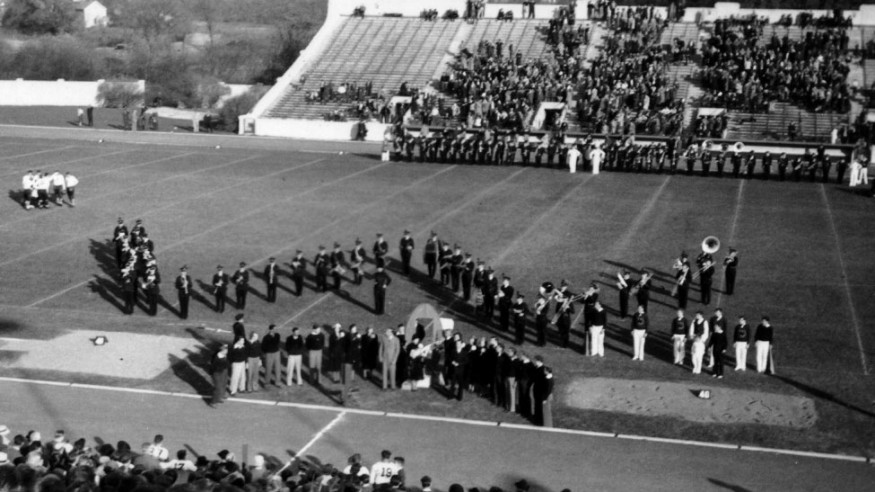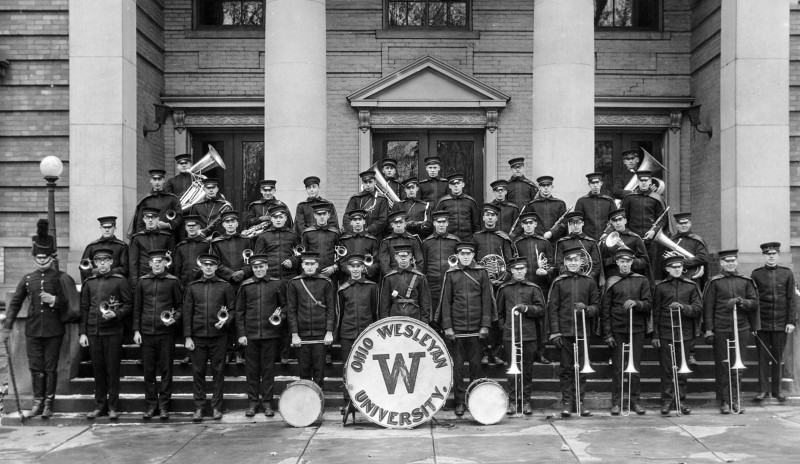
Forward March
Ohio Wesleyan Making Strides to Restore Marching Band After 56 Years
Brennan Angle is ready to drum up some excitement. The Ohio Wesleyan University junior was a percussionist in high school and looks forward to taking the field with the OWU Marching Band in fall 2018.
“I have wished we had a marching band since I came to OWU, and I am extremely excited that we are finally getting one,” says Angle of New Franklin, Ohio. “I can’t wait to make history as being part of the return of the Bishop Marching Band.”
‘A Grand Gesture’
Mary Kate McNally, a graduate of Kent State University, was hired in August to restart a marching band on OWU’s campus. She currently is recruiting for the band, which includes visiting high schools to trumpet news of this Ohio Wesleyan opportunity.
“Sometimes we find potential students who would be Bishops, if we only had a marching band,” McNally says.
When the Marching Bishops came to a halt in 1962, the music did not die with them. Since then, Ohio Wesleyan’s pep band has been playing in the grandstands of home football games.
Dwayne K. Todd, Ph.D., vice president for student engagement and success, said rebuilding the marching band after a 56-year hiatus “is a great opportunity for students who want to continue their high school marching band experiences and a fun way to add even more energy and excitement to the campus and community.”
McNally has said she is excited to lead the new group, noting: “I am thrilled to become a member of the Ohio Wesleyan family under such encouraging circumstances. To start a marching band is a grand gesture of love for music and the performing arts.”

Historical Notes
Ohio Wesleyan first struck up the band in 1889 with the creation of the all men’s Military Band. The first mention of the band, according to Ohio Wesleyan’s First Hundred Years by Henry Clyde Hubbart, came when the band played to welcome a lecturer at the local train station.
In the 1920s, the Military Band faded out as concert and marching bands were formed. During this period, the Bishops marched in their first football halftime show.
In the mid-1930s, the marching band was struggling financially, according to Ohio Wesleyan’s student-run newspaper, The Transcript, with the Marching Bishops having more members than uniforms.
Despite this, the band continued to be a source of pride and fun during this era. According to the 1936 Le Bijou yearbook, out-of-town games created memorable moments, including when “a few wide-a-wake but slightly bored members once bought two pounds of jelly beans and bombarded fellow musicians with the ammunition from the rear of the bus.”
In 1938, The Transcript noted a drop in membership and suggested the band waive its $2 participation fee (the equivalent of $33 today), spend more time on marching, and secure funds for more “flashy” uniforms.
Women were first admitted to the marching band in 1950 as majorettes, not musicians. The year prior, a Transcript survey showed 61 percent of students said women should be allowed to join as musicians, which became a reality a few years later.
However, the fun of uniforms and marching formations did not last. In 1962, the band stopped marching because of “financial and recruiting obstacles,” according to a 1962 Transcript report.
Ready for a New Era
McNally says her goal is not only to launch the OWU Marching Band successfully next fall, but also to create a vibrant group that is around a hundred years from now.
“I believe every event could be made better with music,” she says. “I hope the marching band establishes a sense of community and pride to be at Ohio Wesleyan.”
The Ohio Wesleyan Marching Band enlivens the 1951 Homecoming celebration. OWU will boast a marching band again in fall 2018.
